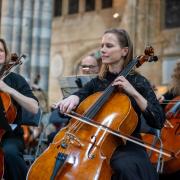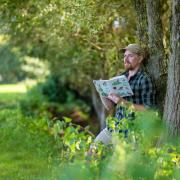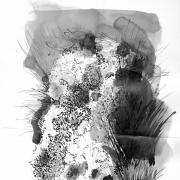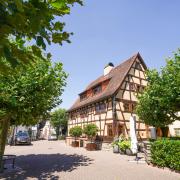Kelvin Boot explores myths magic folklore and facts of the season
Natural Histories of Christmas
Kelvin Boot explores myths magic folklore and facts of the season
Reindeer Reindeer used to be found in Devon. In fact, their remains have been excavated in Kent’s Cavern, but as the climate became warmer after the Ice Age they moved north to Scandinavia. The story of the flying reindeer might be due to the fact that their Laplander herders feed them fly agaric mushrooms which gets them frisky and make them jump around. The Lapps themselves get their share from the red-and-white garbed (copying the toadstool colour scheme) shaman who climbs through a hole in the roof which serves as entrance, exit and chimney, and down a ladder to dispense the hallucinogenic fungi – sound like anyone you might expect on Christmas Eve? Oh, and Rudolph’s red nose is not caused by air friction due to the speed of travel, or to an excess of sherry, but may be the result of one of the many nasal parasites that infest reindeer.PS If you don’t believe in flying reindeer, check out www.noradsanta.org to witness Santa’s journey around the globe on Christmas Eve.
Robin The robin might be the gardener’s friend, but he will fly into battle with other robins who trespass on his territory. Red breasts, fiery amongst the dull winter foliage and twigs, are all part of the show, and robins will attack anything that resembles a rival, including their own reflections. Traditionally the red breast is said to be evidence of the robin’s bravery – either scorched whilst taking precious water drops to the damned souls in hell, or while bringing fire to man from the underworld, or from the blood of Christ as the robin attempted to pull the nails from the cross at the crucifixion. Also the first postmen were called redbreasts, because of the colour of their uniforms, one of the reasons they appear on cards at Christmas.
Mistletoe Great bunches of mistletoe can be seen growing in the tall poplars along the edge of the M5 as you drive into Somerset and Gloucestershire, but there are places such as old orchards and churchyards where it still grows. Mistletoe has long been associated with the druids who were said to cut the magical growth with a golden sickle to maintain its powers. The ball-like growth in the dark mid-winter was surely a sign of something that was above nature; it appeared to have no roots and its milky paired berries a symbol of fertility, which is why we still kiss beneath it.
Christmas Dinner Just how ‘British’ is turkey with all the trimmings? Well not very, actually. Potatoes, which originated in the mountains of South America, were said to have been introduced by Sir Walter Raleigh to the court of Elizabeth I. Brussels sprouts are from Belgium, peas from the Mediterranean – courtesy of the Romans who also gave us sage and parsley and chestnuts. The onion originated in Egypt while carrot is native to Afghanistan, and the now de rigueur cranberry is from the US. The name turkey seems to come from the idea that any exotic species must come from the mysterious East, and the first birds to seep through to England in around 1523 were thought to come from Turkey and so became known as ‘turkie birds’. They soon became established as the preferred fowl at banquets, ousting the tougher-meated swans and peacocks. A real claim to fame for turkeys is their ability to crush bones and even iron bars in their gizzards, so they became the preferred fowl of gangsters too, consuming parts of murder victims, leaving no trace or evidence. So, if you’re having trouble cracking your nuts, consider the turkey who reduced 24 walnuts to powder in four hours, while another flattened an iron tube in a single day!
Holly & Ivy Both shrubs are extremely common and important within the county. Ivy is often regarded as a destructive plant but is incredibly valuable for wildlife, providing food for numerous caterpillars and birds, shelter and hibernation sites for many other animals, and (although you won’t believe me) it only damages already suspect stonework. The holly is a useful berry-bearing plant that produces its berries when there is little else around, especially for birds. The prickly leaves are a defence against grazing animals and usually only occur at the lowest branches; high above, the leaves are thinner and rounder, perfect light gatherers. Holly and ivy were venerated by the pre-Christian religions and became part of the later Christmas rituals of decking the halls with greenery as a reminder that winter really would come to an end. These are both shrubs of the Feast of Saturnalia, and it is said that cups made from their wood minimised the effects of the alcoholic liquors they contained, very convenient when the celebrations reached their height.
Christmas Tree The first Christmas tree was introduced to Britain by Albert the Prince Consort from Germany, but where did the Germans get the idea? It all goes back to Crediton where, in 680 AD, St Boniface was born. Boniface was apostle to Germany and travelled the land bringing the word to the pagan tribes. Boniface was said to be so outraged at the barbarity of the tribes, including decorating sacred oaks with the body parts of their victims, that he cut down a mighty oak. Springing from the roots of the ‘holy’ tree, a tiny conifer, bright green in the dark forest, burst forth – a sign of renewed life, hope and of God’s power. This became a symbol of Christmas. ILLUSTRATIONS: MIRIAM LATIMER


























